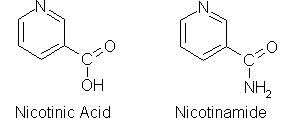Niacin
Niacin (vitamin B3) is the name for nicotinamide and nicotinic acid. It is part of coenzymes (nicotinamide adenine dinucleotide - NAD + and nicotinamide adenine dinucleotide phosphate - NADP +). It can be formed in the liver from tryptophan, but its biosynthesis is very slow and requires vitamin B6.
Source[edit | edit source]
The source are mainly - meat, fish, cereals.
The recommended daily dose for adults is 13-17 mg, depending on age and gender.
Deficit[edit | edit source]
Pellagra is caused by a current deficiency of niacin and its precursor tryptophan. Today, it is very rare, mainly in poor and developing countries or refugees. It occurs in people who feed mainly on corn. According to the symptoms, the name "three D disease" is sometimes used as a mnemonic aid - dermatitis, diarrhea, dementia.
Excess[edit | edit source]
Manifestations of excess are not known. High doses of food supplements cause vasodilation, warmth, inflammation of the gastric mucosa, damage to liver cells. Intake should not exceed 35 mg / kg / day.
Pharmacological use[edit | edit source]
Nicotinic acid (niacin) and its derivatives are used to treat hyperlipidemias. They inhibit the secretion of VLDL from the liver and increase peripheral lipoprotein lipase activity. This leads to a reduction in circulating VLDL (and TAG) and also LDL (cholesterol). In adipose tissue, on the other hand, it blocks intracellular lipase, which means the release of fatty acids from stores, which further reduces the supply of TAG to the liver and reduces VLDL synthesis.
- Side effects
- [1]
- harmless vasodilation (mediated by the release of prostaglandins) in the cutaneous bed associated with subjective feelings of heat - can be managed by acylpyrin;
- in 1/5 treated cases there is hyperuricaemia manifested;
- skin rash.
Links[edit | edit source]
Related articles[edit | edit source]
References[edit | edit source]
- Deutsche Gesellschaft für Ernährung, Österreichische Gesellschaft für Ernährung, Sweizerische Gesellschaft für Ernährungforschung, Sweizerische Vereinigung für Ernährung. . Referenzwerte für die Nährstoffzufuhr (DACH). 1. edition. Frankfurt am Main : Umschau/Braus, 2000. 216 s. ISBN 3-8295-7114-3.
- MARTÍNKOVÁ, Jiřina, Stanislav MIČUDA a Jolana CERMANOVÁ. Selected chapters from clinical pharmacology for bachelor study: Therapy of hyperlipidemia [online]. ©2001. [cit. 2010-07-05]. <https://www.lfhk.cuni.cz/farmakol/predn/bak/kapitoly/hypolipidemika-bak.doc/>.
Kategorie:Vložené články Kategorie:Hygiena Kategorie:Biochemie Kategorie:Fyziologie Kategorie:Kardiologie Kategorie:Farmakologie Kategorie:Vnitřní lékařství

